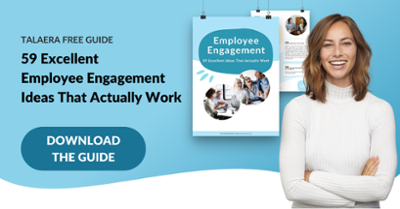By Ming Wu on Jan 26, 2023 6:45:00 AM
Globalization means many of us are enjoying the benefits of working in a more diverse team, but diversity can bring challenges around communication. Savvy HR managers are rethinking communication strategies to facilitate effective communication in a diverse workplace. They understand the impact poor communication can have on a business. Business Insider reported on a survey that found poor communication contributed to increased stress, delayed or incomplete projects, missed performance goals, poor employee engagement, and lost sales.
So how do you ensure your business doesn’t suffer these consequences? Let’s explore four categories of barriers to effective communication in the workplace (language barriers, inclusion barriers, cultural barriers, and environmental barriers). We’ll also look at how to overcome them with tips for effective communication with diverse workplace audiences.
#1 How to overcome language barriers

Multinational organizations should be aware of the following potential workplace language barriers:
Help employees achieve common language proficiency
The most talented of employees cannot perform at their best without sufficient language skills to communicate effectively with coworkers and clients. It can cause misunderstandings, missed deadlines and can even be dangerous. TIP: Employees must have the necessary skills and confidence in their common language at work. HR teams should consider business English training a worthwhile investment to enable employees to do their best work.
Explore our business English programs
Limit colloquial phrases
‘They hit it out of the park!’ is a phrase commonly used in North America. It’s a reference to baseball and means ‘they did an excellent job’. Coworkers who are proficient in English, but with no interest in sport and are not from North America, might not understand its meaning. People use colloquialisms quite naturally, but in a diverse workplace, it can cause confusion. TIP: Encourage employees to use the standard version of your common language and avoid regionally specific colloquialisms.
Avoid jargon
The use of technical language in wider communications presents a challenge in understanding. Those who are not developers may not understand ‘HTML element’ and those who are not seamstresses may not be familiar with ‘grade seams’. TIP: For effective communication, employees should be reminded to use ‘plain English’ and avoid technical jargon when addressing coworkers in different roles and departments.
#2 How to overcome inclusion barriers

To ensure effective communication in a diverse workplace, employees should keep their communication inclusive by avoiding the following:
Use inclusive language
Non-inclusive language can be difficult to understand and can result in audiences feeling excluded or offended. People often use non-inclusive language unintentionally and don’t mean to confuse or offend their audience. TIP: Encourage the use of inclusive language in the workplace. Using plain English, short sentences, and providing clear instructions accommodates coworkers with different skill sets and language abilities. Inclusive language is free from words and phrases that might cause someone to feel excluded or offended. It makes people feel their differences are valued and that they are part of the conversation. For example, using ‘chair’ or ‘chairperson’ rather than ‘chairman’ keeps the communication gender-neutral, avoiding gender stereotypes, and is respectful to chairs who are male, female, or non-binary. This is just one example and there are many that we should be aware of. Share inclusive language resources with your employees to help them incorporate inclusive language into their communications.
Make communication accessible
Effective communication must be accessible. If some team members work remotely, a notice pinned to a board in reception is not accessible. TIP: Talk to employees about considering their audience’s needs when communicating and commit to providing resources they need to make their communications accessible. For example, if members of your team are blind, ensure documents are screen-reader compatible. For coworkers who are hearing impaired, arrange a sign language interpreter at the next conference. Use images to make signs more accessible to those with dyslexia or for whom English is a second language, and provide communications training to those who are not proficient in the language.

Remember regional teams
Teams based in regional offices can feel excluded and overshadowed by the head office. They might receive company-wide emails about ‘Pizza Friday’ or the annual conference, taking place at the head office. Over time, teams in regional offices can develop an ‘us against them’ attitude and silos can form, which discourages communication. TIP: Employers should ensure any social perks at the head office are matched at regional offices, regional news and successes are reported in company updates, and events are held in different locations, so the same teams are not expected to travel each time. Be sensitive to time differences too. Schedule calls and deadlines with regional working hours in mind. This kind of inclusive communication conveys appreciation and instills a sense of belonging.
#3 How to overcome cultural barriers

International businesses can experience cultural barriers to communication if employees are unfamiliar with local business etiquette and customs, which may lead to poor employee experience. As working relationships develop, communication style evolves to suit individual preferences, but cultural awareness gives us a good indication of how we should communicate at the beginning of a partnership. Here are some examples of cultural differences we should be aware of to keep communication open and effective.
Be aware of cultural differences in time perception
Working hours vary across cultures, affecting how you can expect to communicate with coworkers and clients. TIP: Be mindful of local working hours when communicating internationally. For example, the French 'right to disconnect' law, designed to preserve work-life balance, means you wouldn’t expect someone in France to respond to emails or hop on a call after hours. If you need a response on the same day, ask your questions early.
Cultural differences in timekeeping can affect communication in a global workplace. TIP: Be prepared to adjust your schedule when meeting clients in another country. For example, factor in an extra 30 minutes when setting up client meetings in Brazil, where it’s not unusual or considered disrespectful to arrive late for meetings. If you have employees in India where timekeeping is generally more relaxed, make sure you agree early on what is acceptable in terms of punctuality. For example, you may be open to flexible working hours, but client deadlines must be adhered to.
How we describe the passing of time can be ambiguous and cultural differences in time perception which also cause miscommunication in business. TIP: Avoid ambiguity (and missed deadlines) by being specific and descriptive. ‘By 5 pm on Friday’ is clearer than ‘by Friday’ or ‘by close of business on Friday’ (business closes at different times in different cultures), ‘in 30 minutes’ is better than ‘shortly‘ and ‘every six months’ is clearer than ‘bi-annually' (which could also mean once every two years).
Research local customs
Customs around meeting someone in a professional setting and how you communicate with each other vary greatly across cultures. A failure to acknowledge such customs can be disrespectful and bad for business. For your next meeting with international participants, spend some time researching their customs and business etiquette. TIP: Cultural awareness training or at least ample research, will save embarrassment and get things off to a good start. To convey respect may require some adjustments to your natural behavior. For example, when meeting a business associate in Japan you should be familiar with business etiquette in Japan. You would learn that you should be dressed formally (even if that means changing just before your plane lands), It is customary to bow and exchange gifts (but don’t open your gift in each other’s company, to save embarrassment if one gift is better than the other). You should present your business card and receive your associate’s card with both hands and study the card you receive before putting it away carefully.
Be sensitive to different communication styles
It may be necessary to adjust your communication style if you have a culturally diverse audience at work. In hierarchical cultures, as you may find in India, coworkers may be reluctant to speak up before their managers and often won’t contradict them. Learn more about communication styles in this podcast episode. TIP: Provide an opportunity for coworkers to express their opinions, perhaps in an email following the meeting, so they feel more comfortable speaking up. Ask questions that cannot be answered with ‘yes’ or ‘no’ to encourage them to share their own thoughts rather than agreeing with you out of respect.
The same negotiation style can get very different results in different cultures. When negotiating a deal in Russia, early disagreements are considered an invitation to a lively discussion, whereas in Mexico such a start could promptly bring an end to any negotiation. TIP: Before embarking on cross-border business ventures, it is wise to research the regional rules of negotiation and be prepared to adjust the way you negotiate accordingly.
There are even culturally sensitive ways to disagree. Using words with too little or too much emphasis can either fail to convey your message accurately or come across insincere or disrespectful. TIP: Before presenting a problem, consider which words would communicate your message accurately without causing offense. You would use downgraded words such as ‘little’ and slightly’ in Peru, Ghana, and Thailand. In Israel, Germany, and France, upgrading your words to ‘completely’ and ‘absolutely’ is acceptable.
#4 How to overcome environmental barriers

Our environment can present barriers to effective communication at work. Below are some examples we should be aware of.
Rethink your physical workspace
Traditional office layouts where managers have individual offices create physical barriers to communication, whereas open-plan offices with cubicles (cellular layouts) can be distracting, cause anxiety, and result in inefficient communication. TIP: To create a workspace free of these physical and emotional barriers, consider a flexible, multi-space layout. With open-plan space, separate rooms, and breakout areas, employees choose where to work depending on whether they need collaboration for team projects, privacy for sensitive discussions, or a quiet area for focus. A study by ResearchGate found employees communicated three times more often, for shorter periods, and left longer between communications when in a multi-space setting compared to a cellular layout. It suggests that this layout encourages more frequent, efficient communication, with more time to concentrate on work between communications.
Set up remote working for good communication
The Institute of Leadership and Management reported that 88% of remote workers struggle with miscommunication. TIP: Provide structure and a culture of regular communication by scheduling regular catch-ups and welcoming impromptu questions and comments from employees. Show empathy when personal circumstances affect employees’ work, so you can openly discuss it and find a solution. Online socializing such as virtual happy hour or quizzes can build relationships and encourage communication.
Choose technology that works for your team
Technology that’s difficult to use, slow, or unsuitable may be hindering effective communication within your team. TIP: Evaluate the messaging platform, project management tool, and conferencing software your team uses. As a team, decide if they meet your needs. There may be industry-specific or customizable alternatives that could make communication smoother.
Create communication opportunities
Without the appropriate time and setting to communicate their thoughts, often employees simply don’t. TIP: Providing different forums for employees to talk openly creates opportunities for them to share ideas or raise issues. For some, a one-to-one meeting is most comfortable. For others, having a less formal mentor to talk to works. Perhaps assigning a champion or committee to certain issues gives employees somewhere to direct their concerns. ‘Town hall’ meetings are a great way to update employees on news and projects across the business and provide an opportunity to discuss issues that have been raised by employees, giving feedback, setting out action plans, or simply acknowledging there is an issue, and committing to resolve it. Read these 59 excellent employee engagement ideas that actually work.
Conclusion
Effective communication in a diverse workforce is key to the success of a global business. Companies may face barriers when trying to achieve a culture of open communication, but identifying these barriers means they can be addressed. HR managers can equip employees with the resources, tools, and training required, and employers should lead by example to build a culture of inclusive, open, and effective communication in their workplace. All these initiatives will, all in all, help you boost employee engagement in your organization.
Looking for more ways to overcome communication barriers?
Overcome communication barriers in your workplace by helping your international teams with personalized business English training.
- Free English webinars - monthly live sessions with one of our communication experts
- Free English guides - download these free ebooks to learn more about business emails, pronunciation, and other communication skills
- Business English Newsletter - get the best offers and receive free content on Business English communication
If you enjoyed this article, keep reading:
- A Quick Guide To Asking Better Questions In Cross Cultural Workplaces
- The Best Business English Idioms And Phrases You Absolutely Need
- 'Stay safe' - How to Send Actually Genuine Emails During the Pandemic
- Useful Answers to Business English Top Questions - Expert Advice
- How To Learn The Difference Between 'Really' And 'Very'?
- 150+ Useful Email Phrases That Will Make Your Life Easier
- 14 Simple Rules That Will Make You A Better Communicator
- Learning Business English? +20 Top Tips You Need To Know
[Originally posted in June 2021; recently updated to add podcast episode]





comments